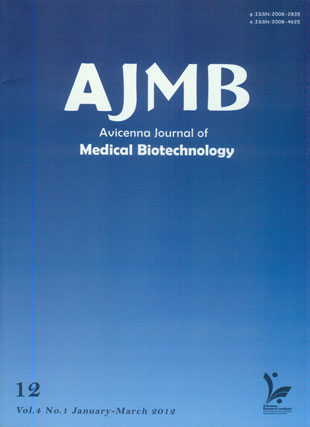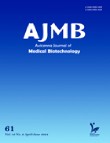فهرست مطالب

Avicenna Journal of Medical Biotechnology
Volume:4 Issue: 1, Jan-Mar2012
- تاریخ انتشار: 1391/01/23
- تعداد عناوین: 7
-
-
Page 1
-
Page 3Cell free DNA (cfDNA) is a genetic biomarker that is present in serum or plasma in high concentration in many types of cancer. Identification of circu-lating cancer related DNA molecules in serum or plasma is a non-invasive tool for early diagnosis and prognosis in many cancer patients. For this review, study selection and data extraction were performed by the authors. Detection of point mutations, microsatellite alterations, DNA hypermethylations and losses of heterozygosity in circulating cell free DNA have been characterized in esophagus cancer. Application of circulating cell free DNA as a biomarker, provide the best opportunity for constructing non-invasive tests for early de-tection, prognosis and management of cancer patients, after therapy in many types of cancer.
-
Page 15In recent years, recombinant monoclonal antibodies and their derivatives have emerged as important targeted therapy agents. Monoclonal antibodies are ex-tremely difficult to produce. So, the cost of production is very high and many people cannot afford these drugs. In this regard, choosing inexpensive and easy ways to manipulate production systems such as bacterial hosts to reduce the cost of manufacturing these critical components are considered as vital step for developmental issues in recombinant expression systems. We, therefore, at-tempted to generate a polycistronic construct of anti HER-2 F(ab')2 fragment antibody for insertion in an expression bacterial plasmid. Also some modifica-tions were made in the hinge region to express antibody F(ab')2 fragment in its authentic form preventing from multiple varieties of disulfide bond formation. Finally, synthesized construct was cloned in pET-32 Ek/LIC vector without using restriction enzyme digestion or ligation reactions. The results of this study show-ed that modified F(ab')2 fragment was simply and successfully inserted in Escherichia coli (E.coli) using the Ligation Independent Cloning technology.
-
In silico Evaluation of Crosslinking Effects on Denaturant meq values and ΔCp upon Protein UnfoldingPage 23Important thermodynamic parameters including denaturant equilibrium m values (meq) and heat capacity changes (ΔCp) can be predicted based on changes in Solvent Accessible Surface Area (SASA) upon unfolding. Crosslinks such as disulfide bonds influence the stability of the proteins by decreasing the entropy gain as well as reduction of SASA of unfolded state. The aim of the study was to develop mathematical models to predict the effect of crosslinks on ΔSASA and ultimately on meq and ΔCp based on in silico methods. Changes of SASA upon computationally simulated unfolding were calculated for a set of 45 proteins with known meq and ΔCp values and the effect of crosslinks on ΔSASA of unfolding was investigated. The results were used to predict the meq of denaturation for guanidine hydrochloride and urea, as well as ΔCp for the studied proteins with overall error of 20%, 31% and 17%, re-spectively. The results of the current study were in close agreement with those obtained from the previous studies.
-
Page 35Recently there has been fabulous excitement in the nano-biotechnological area for the study of nanoparticles synthesis using some natural biological system, which has led the growth advanced nanomaterials. This intention made us to assess the biologically synthesized silver nanoparticles from the leaf of Suaeda monoica (S.monoica) using 1 mM silver nitrate. The leaf extract of S.monoica incubated with 1 mM silver nitrate solution and characterized by UV- spectrometer and AFM. The effect of synthesized silver nanoparticles on Human Epidermoid Larynx Carcinoma cell line was evaluated by the MTT colorimetric technique. As a result we observed gradual change in the colour of extract from greenish to brown. The synthesized silver nanoparticles con-firmed by UV at 430 nm and spherical shape identified in the range of 31 nm under AFM. The effect of silver nanoparticles on Human Epidermoid Larynx Carcinoma cell line exhibits a dose-dependent toxicity for the cell tested and the viability of Hep-2 cells decreased to 50% (IC50) at the concentration of 500 nM. Further findings will be determined the exact mechanisms of this cost effective Nano-treatments.
-
Page 41Expression of receptor tyrosine kinase Ror1 in a wide variety of cancers has emerged as a new era focusing on targeting this receptor in cancer therapy. Our preliminary re-sults indicate the presence of a truncated transcript of Ror1 in tumor cells. The trun-cated Ror1 encompasses extracellular and transmembrane domains, lacking catalytic kinase domain (Ror1-ECD). As enzyme activity is highly dependent on the catalytic domain, we were wondering how this transcript and its encoded protein could play a possible role in tumorigenesis. To understand the function of this truncated transcript and whether or not the encoded protein translocates to the cell surface, we construct-ed a mammalian expression vector containing exon 1 to exon 8 of human Ror1 gene as a model system. The encoded protein by this construct covers the entire extracellular and transmembrane domains of Ror1. The Chinese Hamster Ovary Cell line (CHO) was used for transfection. Our results showed that this construct could express Ror1-ECD at protein level and also the protein could effectively translocate to the surface of transfected cells. Such model may suggest that a proportion of Ror1 molecules ex-pressed by tumor cells are not full-length Ror1. This notion may be considered when applying flow cytometry using antibodies against Ror1 for screening of tumor cells in order to avoid any miscalculation in the number of Ror1 molecules expressed by tumor cells. Furthermore, such expression may bring about assumptions on functional roles of Ror1-ECD in tumorigenesis, which requires extensive functional studies.
-
Page 47Over the years, the use of plastics has complicated the problem of disposal of solid wastes. One strategy to reduce plastic waste is the use of biodegradable plastics. A group of these plastics are polyhydroxyalkanoates (PHAs). To date more than 250 different microorganisms are known to synthesize and accumulate PHA. Most Pseu-domonas strains are able to accumulate mcl-PHA. In previous studies, the phaC1 and phaC2 genes were identified in Pseudomonas aeruginosa (P.aeruginosa) PTCC 1310 and were cloned. The aim of this study was to express these genes and optimize the conditions for their expression. The inserts obtained from vectors pTZPHAC1 and pTZPHAC2 were subcloned into pET15b expression vector. After transformation of competent Escherichia coli (E.coli) BL21 (DE3) cells with recombinant plasmids, expres-sion was induced using IPTG. By changing expression conditions such as IPTG concen-tration, time and temperature of incubation with IPTG, the expression conditions for these enzymes were optimized, and the obtained results were compared using proper statistical analysis. The PHA synthase genes were induced with IPTG and the expres-sed 62 kDa protein was observed and purified. By changing expression conditions, 1 mM IPTG, 37 °C and a 2 hr incubation provided the highest level of protein pro-duction in E.coli cells. These results suggest that induction condition of PhaC genes can influence expression of PHA synthase enzymes.


